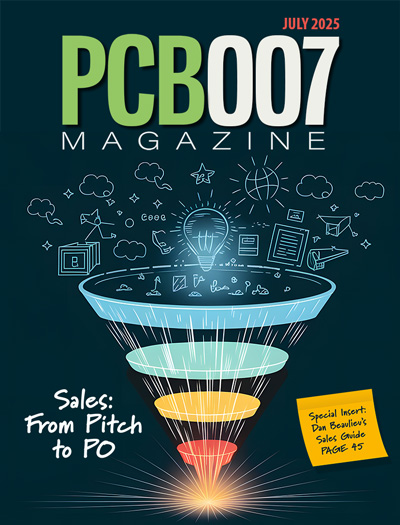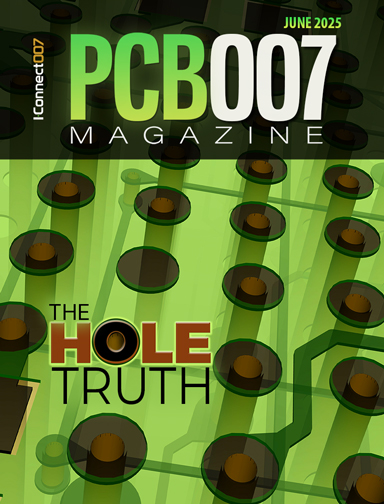-

- News
- Books
Featured Books
- pcb007 Magazine
Latest Issues
Current Issue
Inventing the Future with SEL
Two years after launching its state-of-the-art PCB facility, SEL shares lessons in vision, execution, and innovation, plus insights from industry icons and technology leaders shaping the future of PCB fabrication.

Sales: From Pitch to PO
From the first cold call to finally receiving that first purchase order, the July PCB007 Magazine breaks down some critical parts of the sales stack. To up your sales game, read on!

The Hole Truth: Via Integrity in an HDI World
From the drilled hole to registration across multiple sequential lamination cycles, to the quality of your copper plating, via reliability in an HDI world is becoming an ever-greater challenge. This month we look at “The Hole Truth,” from creating the “perfect” via to how you can assure via quality and reliability, the first time, every time.
- Articles
- Columns
- Links
- Media kit
||| MENU - pcb007 Magazine
CES 2017: Disruptive Technologies
January 16, 2017 | Dan Feinberg, Technology Editor, I-Connect007Estimated reading time: 16 minutes
Autonomous vehicles are an area showing amazing progress in just the last year. I covered this rapidly advancing technology in some detail just over a year ago, you can find that article here. However, there has been much progress in the last year and also much commitment to making this happen by the automotive industry.
It is interesting that I focused on NVIDIA at that time. At that time, they were working with a number of major automotive companies with the goal of partnering with some of them to bring the dream of self-driving vehicles to reality. This year at CES NVIDIA announced partnerships with Audi, with both companies committing to have fully autonomous vehicles available by the year 2020.
Later in the show we received a text saying that if we would immediately come to the Mercedes booth Jen-Hsun Huang would be making a major announcement. That was interesting because if there was any major announcement to be made why wait less than 48 hours after the Key-Note address? Obviously, it must be something that might have been in the works, but in my humble opinion, not finalized until meetings were held at CES. The news was that NVIDIA and Mercedes announced a partnership, so Mercedes is now committing to their AI path.
What is the disruptive technology behind the rapidly advancing success of autonomous vehicles, it is AI (Artificial Intelligence). AI of this power requires a supercomputer of sorts and the mini supercomputer in a cigar box of choice running the autoploid system for many is the DRIVE PX 2. The new Tesla Model S is capable of fully autonomous driving with expected software updates.
Some additional interesting announcements and progress shown: Baidu featured their L3 autonomous driving solution for environmental sensing, based on a Baidu created High Definition Map. Raw HD map data is processed via DRIVE PX 2 to detect and classify the surroundings, such as lane marking, and traffic signals, signs and other landmarks. Working with all the world’s major mapping companies so more of the world’s roads will be mapped sooner. These high-definition maps, accurate down to centimeters, are vital to enabling vehicles that can autonomously zip through the world safely and efficiently.
At the show Zenrin, Japan’s biggest mapmaker, announced Wednesday it’s working to streamline its map creation process using PX 2 powered AI.
LG featured a multi-screen vehicle cockpit demonstration. Finally, at the outside exhibit, you could see an Audi Q7 piloted driving concept and the NVIDIA BB8 test vehicle that both use DRIVE PX 2 as their brain. The upcoming vehicles, just a year or so away, are learning on their own. And that’s perhaps the surest sign that AI cars are here to stay.
And just the other day I received news that at CES 2018, one year away, there will be a number of fully autonomous shuttles fully in use shuttling us from hall to hall and from event to event.
In addition, I was able to try the latest Mercedes concept car that tends to the driver’s physical (and mental?) state. Upon sitting in the car and holding the steering wheel, it quickly measured my blood pressure, heart rate and I guess other things, and gave me a message as to my mood; it played music and adjusted the odor of the air flow using ionized air to elicit a calm attitude for safe driving. I do not know if this is something we want or would need, after all if the car is driving itself, why? But the fact that it can be done shows how far things have progressed.
As far as disruptive technologies, the one that seems to change our everyday lives most in the next five-plus years is autonomous vehicles. The automotive industry has incorporated technology at an ever-increasing speed; in the last 25 years, we have added cellular communications, GPS navigation, various warning systems and greatly enhanced audio and comfort features, but as the man once said, “You ain’t seen nothin’ yet.”
No doubt that fully autonomous travel in your own car is not only possible, it is already here and will be widely available before our next presidential election. Assume that in the year 2027, just ten years, we will live in a world of 100% fully automated cars, no human driving. After all, the only thing that the supercomputers and up-to-date network mapping will not be able to determine is what humans that it shares the road with will do. What will this world look like? I can see highways being limited to just driverless cars and I predict it will start here in California. After all this is the state where the government knows more about what is good for you than you do, However, in this case they might be correct (if it happens and I believe it will.) Per Rory Buckeridge: “Well, first and foremost, it’s a much safer place to be. Road death is the eighth leading cause of death, with between 90% and 95% of car accidents the fault of human error.” The economic cost of road accidents is estimated to be around $277bn in 2013.” It will be a very different world for sure and while there are many disruptive technologies that are about to mature, I believe that this is the one that will have the greatest impact on our lives, our legal system and our economy. It is certainly one that we will continue to follow with great interest. After all, the next car we buy may very well be the last one we will be able to drive any time and any place we wish.
On a lighter note, my award for the most, uh, surprising offering of the show, how about a pair of underwear designed to protect you from the radiation emitted from that smartphone that you keep in your pocket. Disruptive? I do not want to know.
Note: Photos by Racheal Feinberg
Page 3 of 3Testimonial
"Advertising in PCB007 Magazine has been a great way to showcase our bare board testers to the right audience. The I-Connect007 team makes the process smooth and professional. We’re proud to be featured in such a trusted publication."
Klaus Koziol - atgSuggested Items
How Good Design Enables Sustainable PCBs
08/21/2025 | Gerry Partida, Summit InterconnectSustainability has become a key focus for PCB companies seeking to reduce waste, conserve energy, and optimize resources. While many discussions on sustainability center around materials or energy-efficient processes, PCB design is an often overlooked factor that lies at the heart of manufacturing. Good design practices, especially those based on established IPC standards, play a central role in enabling sustainable PCB production. By ensuring designs are manufacturable and reliable, engineers can significantly reduce the environmental impact of their products.
50% Copper Tariffs, 100% Chip Uncertainty, and a Truce
08/19/2025 | Andy Shaughnessy, I-Connect007If you’re like me, tariffs were not on your radar screen until a few months ago, but now political rhetoric has turned to presidential action. Tariffs are front-page news with major developments coming directly from the Oval Office. These are not typical times. President Donald Trump campaigned on tariff reform, and he’s now busy revamping America’s tariff policy.
Global PCB Connections: Understanding the General Fabrication Process—A Designer’s Hidden Advantage
08/14/2025 | Markus Voeltz -- Column: Global PCB ConnectionsDesigners don’t need to become fabricators, but understanding the basics of PCB fabrication can save you time, money, and frustration. The more you understand what’s happening on the shop floor, the better you’ll be able to prevent downstream issues. As you move into more advanced designs like HDI, flex circuits, stacked vias, and embedded components, this foundational knowledge becomes even more critical. Remember: the fabricator is your partner.
MKS’ Atotech to Participate in IPCA Electronics Expo 2025
08/11/2025 | AtotechMKS Inc., a global provider of enabling technologies that transform our world, announced that its strategic brands ESI® (laser systems) and Atotech® (process chemicals, equipment, software, and services) will showcase their latest range of leading manufacturing solutions for printed circuit board (PCB) and package substrate manufacturing at the upcoming 17th IPCA Show to be held at Pragati Maidan, New Delhi from August 21-23, 2025.
MKS Showcases Next-generation PCB Manufacturing Solutions at the Thailand Electronics Circuit Asia 2025
08/06/2025 | MKS Instruments, Inc.MKS Inc, a global provider of enabling technologies that transform our world, today announced its participation in Thailand Electronics Circuit Asia 2025 (THECA 2025), taking place August 20–22 at BITEC in Bangkok.


